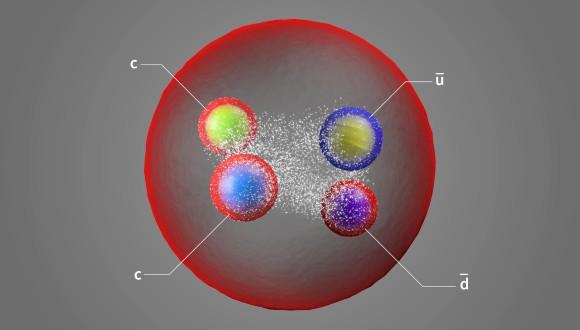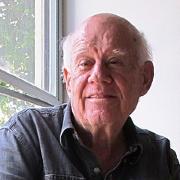Longest-lived exotic hadron discovered at CERN confirms 2017 prediction of Prof. Marek Karliner
TAU Prof. Marek Karliner and Prof. Jonathan Rosner correctly predicted the mass of the exotic Tcc+ subatomic particle
Scientists at the giant LHC particle accelerator operating near CERN's headquarters in Geneva, Switzerland, reported on July 29 that they had discovered a new subatomic particle made up of two charm quarks, an up antiquark and a down antiquark. Known as Tcc+, the new particle belongs to a rare class called tetraquarks and its unusual composition makes it the longest-lived exotic hadron found so far.
Exotic hadrons are usually not very stable and decompose relatively quickly into ordinary hadrons, but the new particle discovered last week, the double-charm tetraquark Tcc+, has an unusually long lifespan, at least three times longer than the exotic particles discovered so far. As described in a recent article in the prestigious Nature magazine, the existence of this tetraquark, with the correct properties, has been predicted four years ago by Prof. Marek Karliner, Professor of Physics at the School of Physics and Astronomy and Director of The Mortimer and Raymond Sackler Institute of Advanced Studies (IAS) at Tel Aviv University, together with Prof. Jonathan Rosner of the University of Chicago.
In a joint article published in 2017 in the journal Physical Review Letters, the two precisely predicted the mass of the Tcc+ particle which has been now discovered. In the same article, they also pointed out that the strong attraction between the two charm quarks is nevertheless not as strong as between two bottom quarks. The binding energy is not large enough to completely rule out a strong decay, which does take place, albeit with a very small natural width.
The experimental verification of these predictions is an important milestone in the understanding of heavy exotic hadrons. The same theoretical toolbox predicts that if the two charmed quarks are replaced by two bottom quarks, the resulting tetraquark Tbb- will not be able to decay at all via strong interactions. It will only be able to decay weakly, via weak interactions. As a result, its lifetime will be approximately a hundred million times longer than the lifetime of Tcc+. This provides the first robust prediction of a stable exotic hadron, the first member of the third class of stable hadrons, on top of ordinary baryons and mesons. The fact that the prediction for the newly discovered Tcc+ particle turned out to be highly precise reinforces the likelihood that the prediction of the stable Tbb- is also correct and that it indeed exists in Nature.
"We have reliably shown there [in the 2017 article] that such an exotic subatomic particle would be stable with respect to the strong nuclear force, something we are not familiar with in Nature today," Prof. Karliner said in an interview with the newspaper Haaretz. "Until today there has been a question as to how accurate this theoretical prediction was. But since the article predicted the mass of the subatomic particle that was just discovered, and it turns out that the prediction was very accurate, it strengthens the theoretical prediction of the second particle which will be a whole new type of matter," he added.
Scientists at CERN will now search for the existence of a particle that could be even more stable than the Tcc+ particle. The Tbb- particle, which the CERN Courier recently called Tcc+’s “beautiful cousin,” could be the next great discovery. According to Prof. Karliner, unlike the exotic particles that have been discovered so far, the Tbb- tetraquark would be stable. "This new discovery provides very strong evidence, although not direct experimental evidence, for the theoretical prediction that matter of this kind indeed exists and is very stable," he told Haaretz.
Installation of part of the LHCb detector — which has since spotted many of the LHC’s new hadron types. Credit: Julien Marius Ordan/CERN
More about “exotic” particles
The discovery, which was announced at the conference of the European Physical Society on July 29, 2021, comes more than a decade after the giant LHC accelerator was inaugurated to detect the Higgs boson particle and made it possible to search for and discover other new particles.
Until recently, the hundreds of quark-containing particles splintering out of subatomic collisions were known to exist only as trios of quarks called baryons (including protons and neutrons) or quark-antiquark pairs known as mesons. The limited number of arrangements perplexed physicists because the mathematical model that described quark behavior did not forbid them from combining in other ways. Scientists hypothesized that there were also "exotic" particles containing four or five quarks in a special configuration and began to reveal their existence in experiments. In recent years, technology has matured to detect these particles, which are not very stable and decompose relatively quickly. The new Tcc+ particle is considered to have a long lifespan before it decays, but “long” in this case is still so short it can hardly be measured in human terms.
Like many other quark states, this double-charm tetraquark was found at LHCb using a method called bump hunting. The experiments are performed by computerized analysis of proton beam collisions moving at a speed very close to the speed of light in the LHC accelerator, which is deployed in a 27-kilometer-diameter ring located at a depth of about 100 meters below the ground. It was bump hunting that revealed the Higgs boson in 2012. So far, 62 hadrons have been discovered at the Large Hadron Collider, but the latest discovery could open the door to searching for and locating new, stable particles that have never before been seen.





